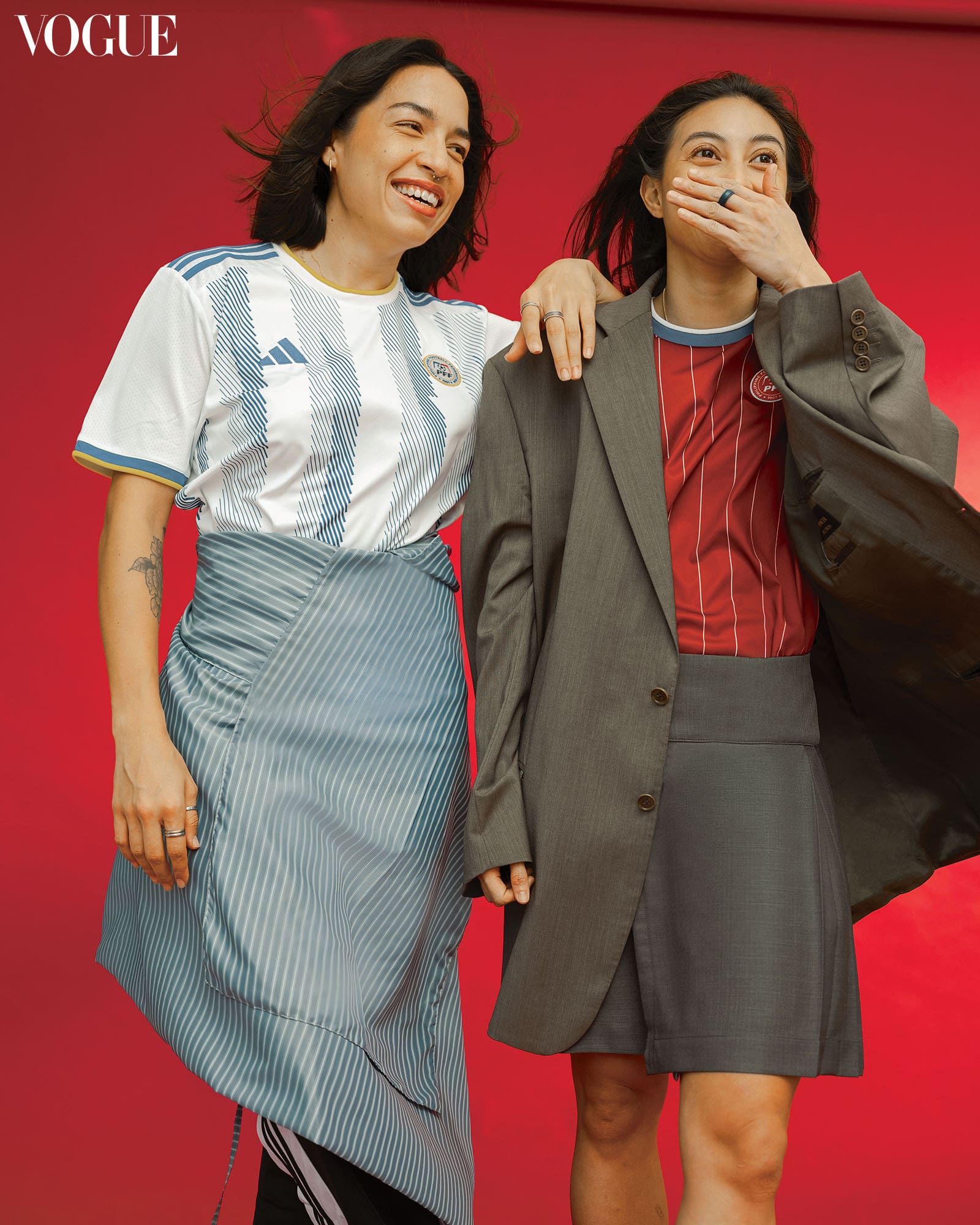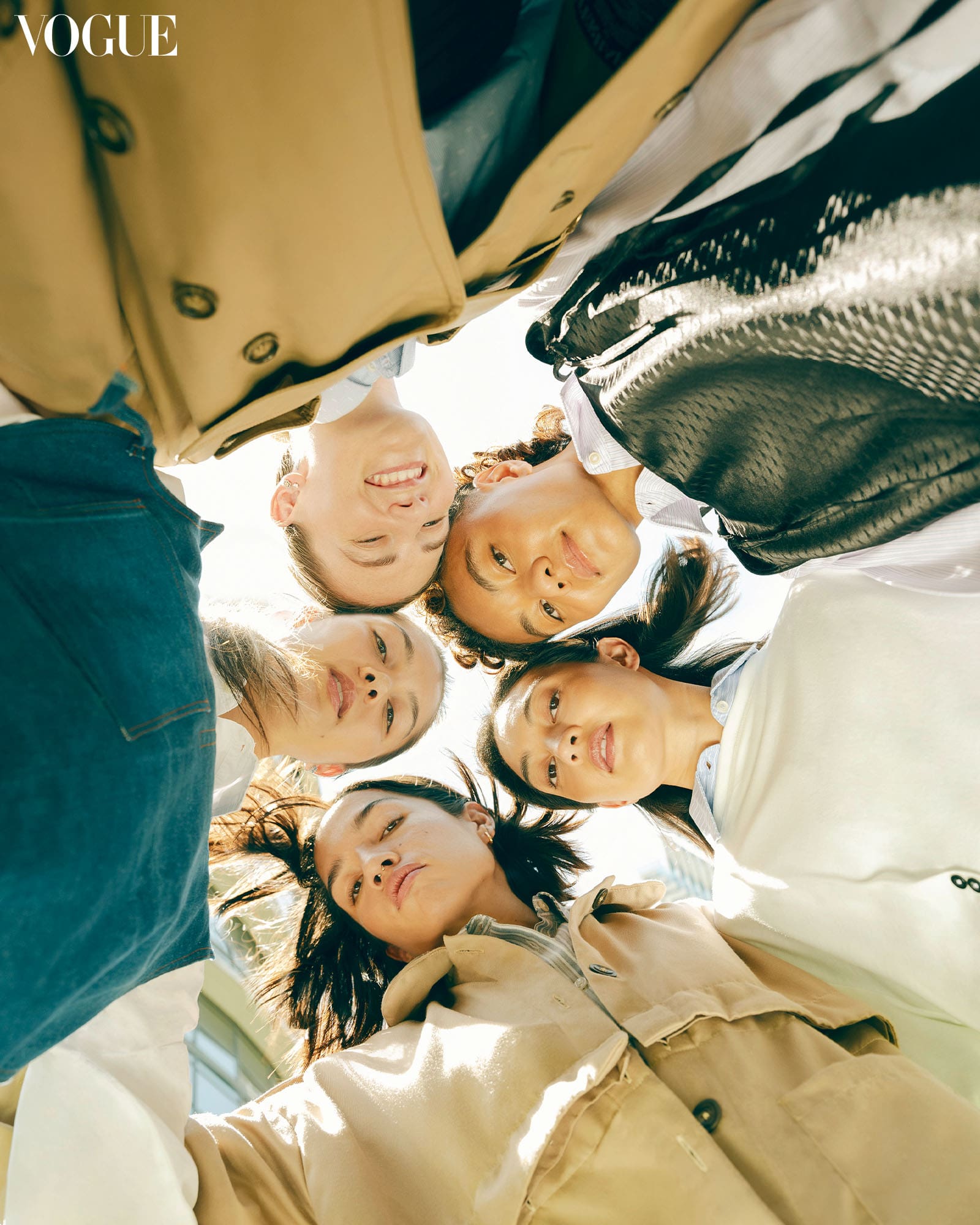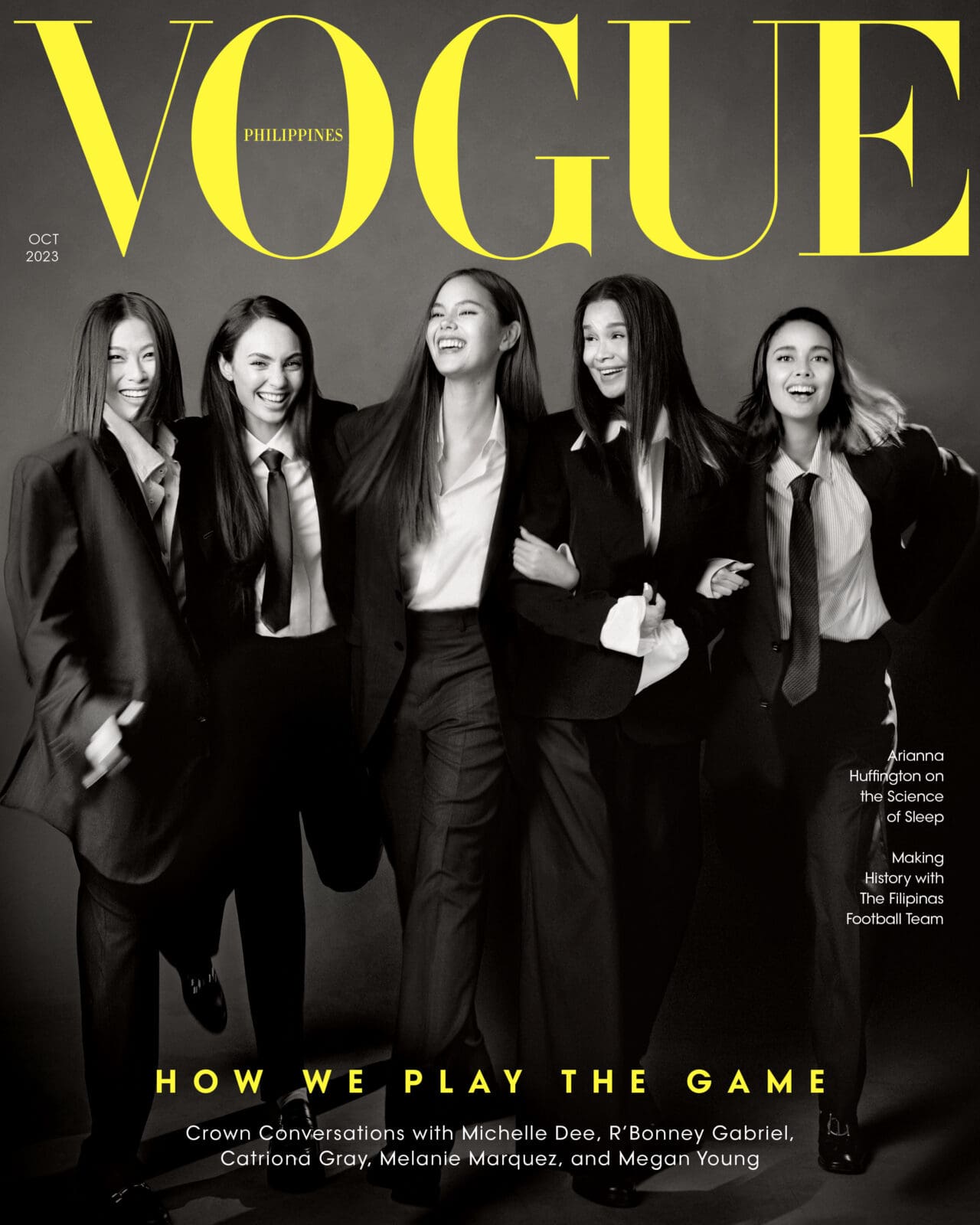For the Filipinas, it was a summer to remember. For Vogue Philippines’ October 2023 cover story, Mia Nazareno sits down with the members of the Philippine National Women’s Football team.
Beauty queens have reigned as role models for Filipino women for the longest time, but recently, it is the Filipino women in sports who are inspiring a newfound national pride and redefining Filipina strength in 2023. For the first time, a Filipino football team qualified for the FIFA World Cup—and it was the Filipinas. Taking it a step further, 27-year-old forward Sarina Bolden secured her place in history when she scored the Philippines’ first goal at the tournament, ultimately defeating hosts New Zealand 1-0 at the Sky Stadium on July 24. Thanks to Bolden’s impressive header against goalkeeper Victoria Esson in the 24th minute, Filipinos were suddenly united as football fans.
The new national obsession with trophies and jerseys can be traced to the COVID-postponed 2020 Summer Olympics held in Tokyo. In 2021, weightlifter Hidilyn Diaz earned the Philippines its first gold medal since joining the international games nearly a century earlier in 1924. Diaz was awarded the top prize after she successfully lifted a total of 224 kilograms in the 55-kilogram women’s division. During the awarding ceremony, spectators witnessed Diaz saluting the Philippine flag with tears in her eyes as the “Lupang Hinirang” played for the first time at the Olympics in front of a global audience. (If you haven’t seen that clip, we dare you to watch it without tearing up.)
Wushu artist Agatha Wong has also gone on to collect gold medals for the Philippines during both the 2017 and 2019 Southeast Asian Games. In the world of motorsport, 18-year-old Bianca Bustamante is carving her own path as the only Filipina driver to join the Formula 1 Academy, a feeder series to F1 where big names like Sir Lewis Hamilton and Fernando Alonso compete.

And finally, following this year’s World Cup, football is the latest addition to the list of sports Filipino women are dominating and consequently making our hearts swell with pride. “We always say: Girls will do it first,” says co-captain Hali Long, who plays center back. “Whatever it is, it’s always going to be a girl who will pioneer her way through, and I believe in that.”
As more Filipina athletes take on the world stage in various arenas, Bolden tells Vogue Philippines that “We’re the moment right now. Women in sports are just booming. And I’m so honored to be even part of that conversation in that way.”
Upon the team’s arrival back in Manila, Bolden and her teammates were greeted with a hero’s welcome with fans excited to see the athletes in real life. Even though the Filipinas didn’t advance beyond the group stage of the World Cup, the final numbers on the scoreboard didn’t really matter to the fans—they’ve remained steadfast in their support for the players, who’ve brought the country and diaspora together through the team’s display of sportswomanship. “The other day, we visited the Senate in Manila, and they literally wrote us into the history books. It’s actually a formal thing and everything,” says Bolden. “It feels crazy. It feels surreal. It feels like I’m still in a dream,” the forward shares in the aftermath of making history.
“Even though the majority of us are Fil-Am, we have put our hearts and souls into this team”
Sarina recounts the moment she found her parents watching her play in their final match against Norway during the World Cup. “It sucked because we got an ass whooping. We lost 6-0. Definitely not the way we wanted to go out. As we were saying goodbye to the fans and giving our thanks, I was all fine and good. But once we finally said goodbye to my parents’ side, they were out there waving and my dad just gave me a thumbs up,” she shares, adding that she promptly lost it after seeing that. “I started crying. It all started with them. I was so proud to do it in front of them, too.”
Before the fanfare and headline-making goal, there weren’t many who saw the World Cup in the team’s future. One of few who did was Inna Palacios, who has been on the national team for more than a decade. “It was such a hard journey because it’s hard to believe in something that you don’t see often, but that’s what you’re fighting for. [You’re fighting to see] that future coming true in your lifetime,” says Palacios. Despite the setbacks, she knew even back then: “Kaya ng Pilipinas.” [“The Philippines can do it.”]
Bolden shares how inspired she is by Palacios, “just for existing and doing what she’s done for us,” explaining how before all the recent media attention they’ve been receiving, they struggled to have matching kits for training. “We barely had water supplied to us. [We] barely had a staff. “For [Palacios] to keep going and going and to believe that there’s a bigger purpose of ‘I want this team to succeed. I know one day we can get to the World Cup’ is just amazing.”

Similarly, Palacios pays tribute to her own mentors and echoes the importance of having early examples of hope. As she recalls her school days at Colegio San Agustin, Palacios brings up a core memory of when her football coaches showed her their bronze medal in futsal from the 2007 SEA Games. “That became part of the dream of wanting that same medal for myself,” she says. “It felt so prestigious. It wasn’t just a medal we won in school with kids. It felt heavy and so real. [It was then] that that dream became tangible.”
For the American and foreign-born teammates, playing for the Philippine national team has brought them closer to the Filipino side of their identity. Bolden, whose mother is Filipino and whose father is African American, reveals how being on this team has taught her more about her Filipino heritage and culture than she had ever known. “I didn’t get that experience [when I was a kid], but I’m getting that now in my adulthood.” The California-bred footballer adds, “Even though I don’t speak Tagalog, I’m going to learn it. It’s one of my goals before I die.”
Bolden isn’t alone in nurturing a deeper connection with her Filipino roots as an athlete for the country. “We’re not just here because we wanted to take it to the World Cup. We’re here because having our Filipino culture is super important to us,” says goalkeeper Olivia McDaniel. Her sister Chandler, who is a forward, shares the sentiment. “We’re just doing something we love, but to be able to have this big of an impact for the country and to help those little girls who are like, ‘I want to do that,’ and bring people into sports and to help soccer grow, it’s an honor to be able to do that for the country.”

On that note, while many have celebrated the team’s success, there have been the inevitable debates on foreign-born players representing the Philippines at international tournaments.
Some critics have questioned whether it’s fair that a majority of the players at the World Cup are American-born and recruited from California. “They have a right to that opinion,” Bolden admits. “But for me, it’s not about where you’re born or where you’re raised. [It’s more about] how you conduct yourself in this space of representing a country. Even though the majority of us are Fil-Am, we have put our hearts and souls into this team,” says Bolden.
Long, who joined the team in 2016, notes that the pre-pandemic and post-pandemic teams “are very different teams,” expressing that she wished the newer girls could’ve been able to experience being immersed with teammates from all over the Philippines, speaking Bisaya and Tagalog. “It’s their own journey to what it means to be Pinoy to them, but it’s not going to have the same gravity as a local, like Inna. All we asked was the girls to care, at their capacity, for what it means to represent the Philippines. I think it definitely showed this past campaign.”
Given how Bolden scored the country its first goal at the World Cup, her decision to play for her mother’s home country has put the Philippines on the map for women’s football.

The discourse surrounding who is Filipino enough to represent the nation wouldn’t be complete without contextualizing the topic with our history of immigration all throughout the 20th century until today. In 2022, it was estimated that 1.83 million Overseas Filipino Workers (OFWs) sent USD36.14 billion back home. “Filipinos are everywhere. We have the luxury to look at other countries because there are so many [of us] out there. [And having a diverse roster] is a great representation of who we really are,” says Bolden. As immigration and OFWs are a major part of our history, culture and economy, so should our mixed heritage Filipinos here and abroad.
While there’s no clear-cut solutions to these issues, Palacios reminds us that these steps forward are a team effort and ultimately pave the way for younger football players. Following the Philippines’ debut at the World Cup, “Now, the little kids can dream and have role models to look up to. For me, I want them to do even more than what we did, and to have more than we had,” says Palacios.
Though she was a reserve at the World Cup, Palacios feels fortunate to have been part of the rise of football in the Philippines. “Not everyone can go through the kind of journey that I went through, with literally no support, to a little support, to a lot of support. And now so there’s so much love—hopefully it’s just the beginning for football development here in the country,” she says.
Looking to what’s next, the girls are hopeful that their success in New Zealand will reinforce a much-needed stream of investment into the team. Before reaching the World Cup this year, Bolden details how on some of the tournaments they had to use men’s hand-me-downs. “We know what is required and what it takes. And unfortunately, it does take a lot of money,” she says. “But look at the payout. Look at what happens when you do invest in us. In the sport. And in this team.”

Following Sarina’s life-changing summer at the World Cup, the footballer brings it back to the basics and tells us why she simply loves the sport. “For me, being this Asian, African-American, queer woman,” says Bolden as she holds up three fingers and laughs. “That’s like…pick one! You can’t be all three! To be on that stage, I know I have a responsibility to keep going because there weren’t many footballers who looked like me playing out there.” She continues, “I love this sport because it’s given me so much. It doesn’t matter what your background is. It doesn’t matter what your sexuality is. If this is what you want, this is the sport that will accept you with open arms because it is so worldwide. If you want to come and be a part of this, soccer accepts you as you are.”
With footballers, race car drivers, weightlifters and other women in athletics ushering in a a different type of Filipino woman taking on the global stage, the diversity of Filipina strength is offering new possibilities of what girls can aspire to. “Stereotypically, when people think about women in something competitive, it’s leaning towards the arts, towards pageantry, which is just as strong and takes a different type of strength to go out and to those things,” says Bolden. “It just shows the range of what Filipino women can do and what we’re capable of. We’re versatile. I know women will continue breaking these boundaries and that glass ceiling. [I know women will] continue making more history because we are strong in so many different ways.”
As 2023 shapes up to be the year of the Filipina athlete, there is one more thing that women in sports did, and that is bringing a nation of several thousand islands together. Because for those 90 minutes on the pitch in New Zealand, Filipinos at home and abroad were on the same team.
By Mia Nazareno. Photographs by Shaira Luna. Styling by Renee De Guzman. Makeup: Angeline Dela Cruz. Hair: Mong Amado. Talents: Chandler McDaniel, Hali Long, Inna Palacios, Olivia McDaniel, Sarina Bolden. Art Director: Jann Pascua. Producer: Anz Hizon. Production Assistant: Bianca Zaragoza. Intern: Ally Nibungco, Jillian Santos, Kyla Uy.

